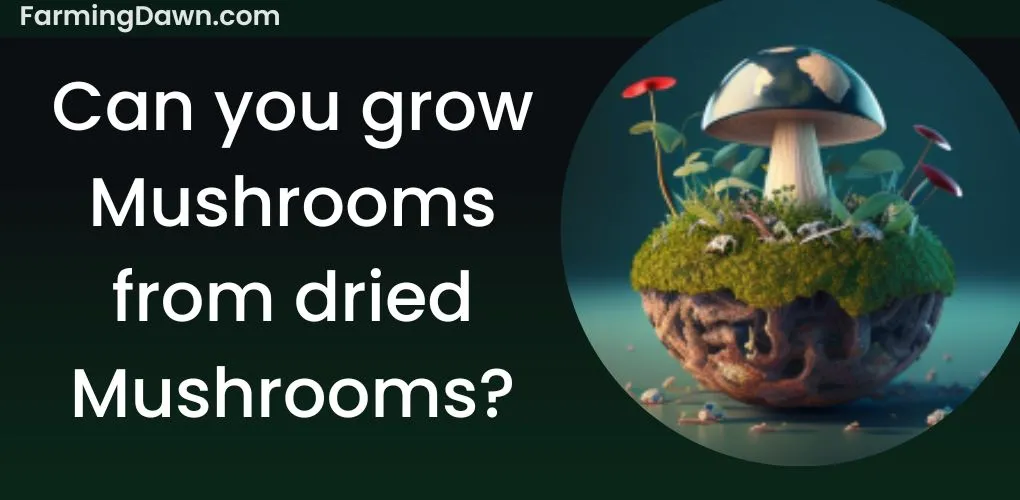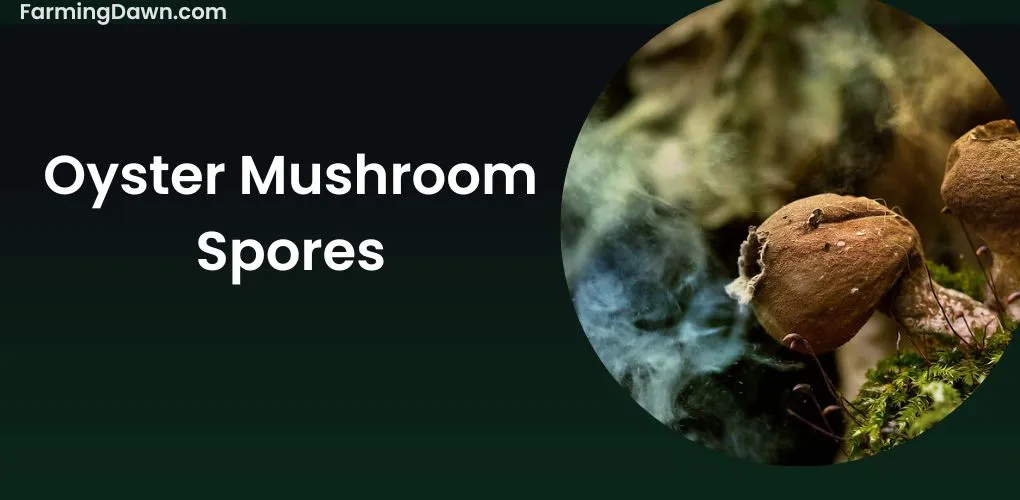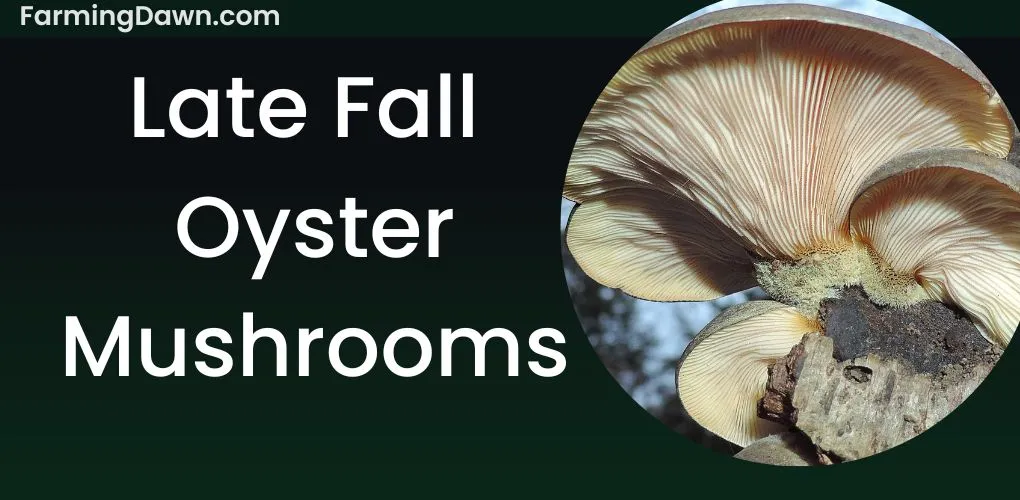Although fresh mushrooms have long been favored by gardeners, dried mushrooms are a common and valuable substitute. But can you grow mushrooms from dried mushrooms? If so, what prerequisites must be met for upkeep and growth?
Today I’ll talk about whether it’s possible to grow mushrooms from dried ones, as well as the steps you must take to do so.
What are dried mushrooms?
Mushrooms undergoing a drying procedure to eliminate their moisture are referred to as dried mushrooms. This is usually done by a method in which fresh mushrooms are often subjected to low heat, air, or a mix of the two until most of their moisture has evaporated.
Note: If you are wondering to grow these mushrooms from these dried mushrooms. I have a whole section for that in the next step.
This is a common technique for preserving, since it increases their shelf life and intensifies their flavor. Dry mushrooms are frequently used in soups, stews, sauces, and other foods. They can be rehydrated by soaking them in warm water or broth.
Here are some common types of dried mushrooms:
- Porcini
- Shiitake
- Morel
- Chanterelle
- Oyster
- Enoki
Different Methods for drying mushrooms
Depending on the size of the mushrooms and the drying method employed, the process usually takes three to five days. You can follow the following methods for drying:
Sun-drying: If the puffballs are to be dried by the sun, they must be stretched out in a single layer on a spotless, dry surface. The mushrooms become crisp and delicate when dried for a long time. Hot, dry locations are ideal for this strategy.
Oven drying: Preheat your oven to 150°F (65°C) and line a baking sheet with parchment paper to prepare for oven drying. Put the sliced mushrooms on the sheet in a single layer with a small spacing between each slice. After roasting the mushrooms for two to three hours, they should be flipped over.
The puffballs are done when they have dried and turned brittle.
Can you Grow Mushrooms from dried Mushrooms?
It is possible to grow mushrooms from dried mushrooms, although it can be a little tricky. The first step is to obtain the spores or mycelium of the fungus you want to develop.
Once you have gotten the spores, the next step is establishing the optimal environment for your mushrooms to thrive. You often need to sterilize your spores before putting them in the media, such as compost, sawdust, or straw.
The next step is to make sure your mushrooms are receiving the right amount of light and fresh air while also maintaining the ideal temperature and humidity levels in the growth environment. This can take trial and error because different mushrooms have distinct growing requirements.
It’s essential to keep in mind that growing puffballs from dry mushrooms is not always a successful method. You might get different results than growing mushrooms from fresh spores, even if you strictly adhere to the directions.
This is because of the damage done during the drying process and mushrooms losing their ability to increase.
How to Grow Mushrooms from dried Mushrooms?
Let’s start with the fundamentals. Mushrooms grow from spores, which are similar to mushroom seeds. The spores are too small to be seen with the human eye. The dried mushrooms that you buy from stores come with spores that can be utilized to produce fresh mushrooms.
You will require the following in order to begin the process:
- bunch of dried mushrooms
- a closed container (such as a plastic box or a big jar)
- sterile foundation (such as sawdust or straw)
- Water
- a spray bottles
Step 1: Get the spores ready.
Start by separating the dried puffballs into small pieces and putting them into the container. The mushrooms and the sterilized substrate should be combined in the container. Lastly, add a small amount of water to the mixture and moisten it with the spray bottle. Put the container away for a few days in a warm, dark area with the lid on.
Step 2: Look for growth.
After a few days, check the container to see if the spores have started to grow. A white, cotton-like growth should be visible on the substrate’s surface. Give it a couple more days if you don’t notice any growth. Once you see growth, you can move on to the next step.
Step 3: Transfer to a growing medium
Transfer the substrate and spores to a growing medium, such as a plastic bag filled with sterilized substrate. Make ventilation holes in the bag before sealing it. Every day spray the bag with water and preserve it in a warm, dark environment.
Consider Growing low maintenance plants Cacti , if you want to give little time to your garden.
Step 4: Watch for the mushroom growth
After a few weeks, you should start to see mushrooms growing from the substrate. To encourage the mushrooms to grow more extensively, you can now relocate the bag to a cooler location with more light. Harvest the mushrooms by gently twisting and pulling them out of the substrate once they have reached the proper size.
Best practices for growing mushrooms from dried mushrooms
This section is for novice gardener to help them regulate the process more successfully. These are all my personal tips that I have tries in my garden:
Choose the Proper Kind of Dried Mushrooms:
You can choose any mushroom variety for growing. But I recommend you choose between Shiitake, oyster, and lion’s mane. These mushrooms have a high success rate and are simple to raise.
Water the mushrooms again:
Rehydrating dried mushrooms is the first trick in producing mushrooms from them. You must soak the puffballs in water for at least 12 hours to prepare them for this. Use warm water whenever possible to hasten the rehydration process.
Provide a favorable environment for growth:
Mushrooms thrive in a dark, humid environment, so you’ll need to create a space that mimics these conditions. Fill a growth container with a sawdust and grain mixture, such as a plastic bag.
Put the mushroom spawn in:
The final trick is mushroom spawn. You will need to add this spawn into your container. The mushroom spawn is the mycelium that will eventually grow into the fruiting body of the mushroom.
Can you get spores from dried mushrooms?
Spores carry out both the growth and reproduction of the mushrooms. As the mushroom achieves maturity, the spores are released into the air and have a wide geographic dispersion. Spores are essential to a mushroom’s life cycle and are also used to produce new mushrooms.
Yes, you can get spores from dried mushrooms, although the process can be challenging, the results aren’t always reliable.
This is because numerous variables may affect the procedure. For instance, it could be challenging to acquire enough spores for growth since some mushroom species produce very few of them. Also, the caliber of the puffball may affect how well the spores disperse, and some mushroom species might not be suited for spore collecting at all.
How to get spores from dried mushrooms?
You’ll need a few things to start:
- Dried mushrooms
- Transparent bag of plastic
- Tidy area
- knife
- One piece of paper
Here is the procedure in detail:
Choose a dried fungus that appears healthy and has a lot of spores to start. You can usually tell if a mushroom has spores by looking at the underside of the cap. If it’s covered in tiny dots, those are the spores.
After setting the mushroom on a spotless surface, carefully cut off the cap with a knife. Given that the majority of the spores will be in the cap try to maintain it as intact as you can.
Cover the cap with some paper and fold it in half to enclose it. To get the spores to come out, gently press down on the paper.
Examine the spores left on the paper after carefully removing the cap. They should be visible as fine dust.
Place the spore-covered paper inside a clear plastic bag and seal it. The bag will help keep the spores dry and guard against contamination from other germs.
You now have spores that you can use to create your puffballs, so congratulations!
Note: You must inoculate a substrate with the spores before using them. This can be accomplished by generating a spore print on a sterile surface or using a spore syringe.
Once your substrate has been inoculated, all that is left to do is wait for the mushrooms to grow.
Can you grow mushrooms from store-bought mushrooms?
Yes, it is possible to grow mushrooms from store-bought mushrooms. But, there are several essential aspects to remember if you wish to succeed.
The type of mushroom you start with is one of the most essential components in the production of mushrooms. Both button and portobello mushrooms, which are frequently used in cooking, make up the majority of the mushrooms sold in stores.
It is possible to cultivate new mushrooms using these varieties. However, the procedure can be a little trickier than just sowing a seed.
Take a mature store-bought mushroom and cut off the stem to start growing mushrooms. To gather spores, place the cap gill-side down on a wet piece of paper and cover it with a bowl for 24 hours. Combine the spawn and spores before transferring the mixture to a growing media like compost, sawdust, or straw.
Maintain the growing medium at the right temperature and humidity for the particular type of mushroom you are cultivating, and keep it moist.
Can you grow mushrooms from fresh mushrooms?
It is indeed possible, and in fact, growing mushrooms from fresh ones is a common practice among mushroom enthusiasts.
If you want to cultivate mushrooms in your garden from fresh mushrooms, you’ll need to mix coffee grounds, cardboard, and mushroom spores to make a substrate.
Keep the mixture moist and place it somewhere dark and damp, like a shaded part of your garden. Little mushrooms ought to start to appear within a few weeks. Harvest them by gently twisting and pulling them off the substrate.
Can you Grow Mushrooms from dried Mushrooms? Final Thoughts
Now, it’s my turn to ask you, can you grow mushrooms from dried mushrooms? Although it can be a bit challenging but drying your mushrooms is a fun activity to perform in your garden. I have made the information as easy as possible so that you people do not have any difficulty in carrying out the process. If you have any additional request, ask me in the comments. Thank you!
Each vegetable has its drying process and storing requirements. Read my other articles to learn more:





